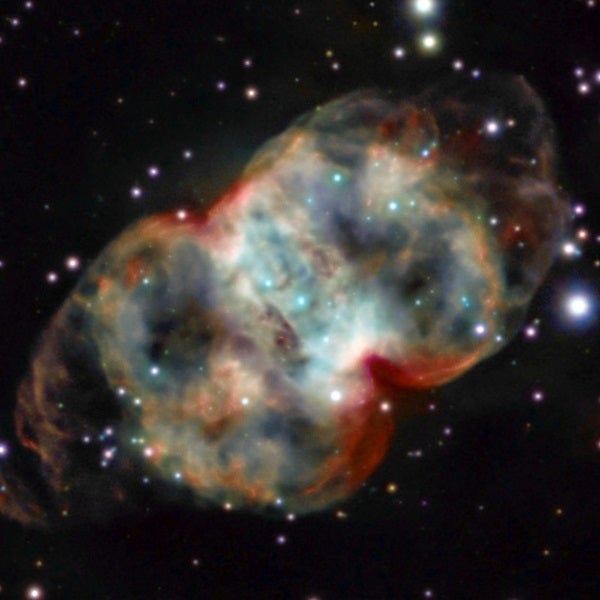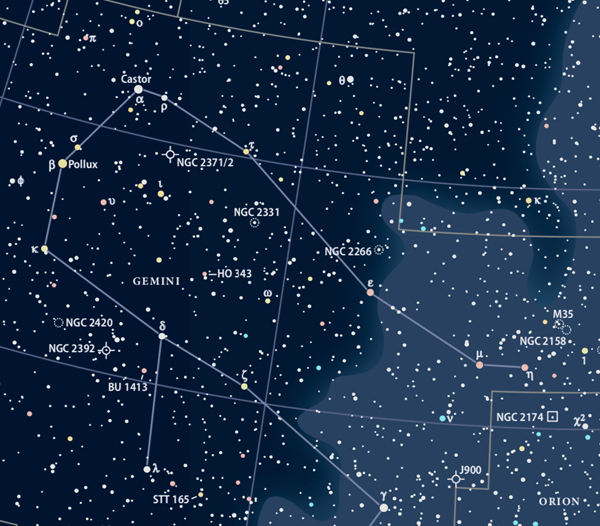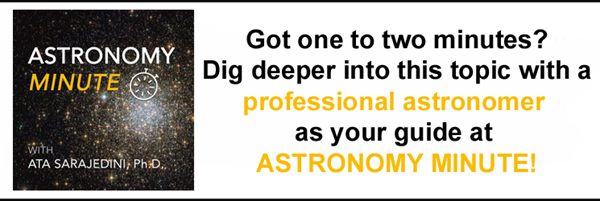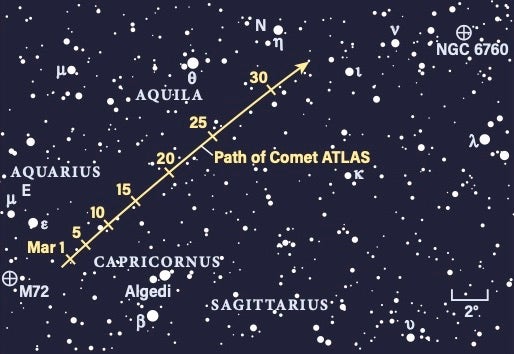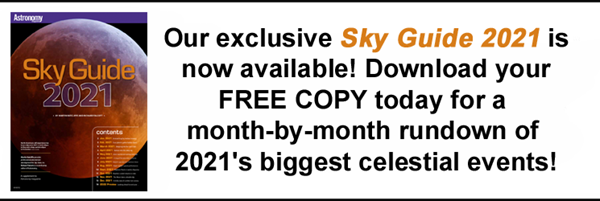Friday, March 5
Mercury passes 0.3° north of Jupiter at 2 A.M. EST. Both planets are visible shortly before sunrise, hanging low in the southeastern sky. You’ll want to use binoculars or a small telescope to spot them — although Jupiter is a bright magnitude –2, Mercury is much fainter at magnitude 0.2. Saturn (magnitude 0.6) sits to the pair’s west.
If you have access to a larger scope, you can also try this morning to find the dwarf planet Pluto, located in eastern Sagittarius, about 12.7° west of Saturn. Glowing a faint magnitude 14, the tiny world is best spotted earlier, before twilight brightens the sky. Its disk appears less than 1″ across and is easy to confuse with a star. However, Pluto’s disk will look slightly “flatter” than the pinprick brightness you expect from stars.
Last Quarter Moon occurs tonight at 8:30 P.M. EST. But to see our satellite in this phase, you’ll need to wait until after midnight, when it rises in the constellation Ophiuchus.
Sunrise*: 6:27 A.M.
Sunset: 5:57 P.M.
Moonrise: 12:30 A.M.
Moonset: 10:22 A.M.
Moon Phase: Waning gibbous (54%)
*Times for sunrise, sunset, moonrise, and moonset are given in local time from 40° N 90° W. The Moon’s illumination is given at 12 P.M. local time from the same location.
Saturday, March 6
Mercury reaches greatest western elongation (27°) at 6 A.M. EST. Take a peek just before sunrise to see how far it’s pulled away from Jupiter in just one day.
If evening observing is more your speed, Gemini is already high in the sky at sunset. The Twins’ two brightest stars, Castor (magnitude 1.6) and Pollux (magnitude 1.2), are relatively easy to find, north of bright Procyon (magnitude 0.4) in Canis Minor. While these two stars are famous — and make excellent observing targets, particularly because Castor is a striking binary system — look away from the Twins’ heads tonight and focus instead on their feet. 20° west of Castor is Propus, also known as Eta (η) Geminorum. (Alternatively, you can use the much closer Mu [μ] Geminorum as a jumping-off point — Propus is 1.8° west of this magnitude 2.9 star.)
The name Propus appropriately means “forward foot” in Greek. This star is the American Association of Variable Star Observers’ featured variable of the month for March. First discovered to vary in brightness in 1865, astronomers now know that Propus’ magnitude changes over a period of 234 days, swinging between 3.3 and 3.9. The star is a red giant, meaning it’s further along in its life cycle than our Sun, and sits about 350 light-years away. Over time, it will evolve into a Mira-type variable — a star featured later this year.
Sunrise: 6:25 A.M.
Sunset: 5:58 P.M.
Moonrise: 1:42 A.M.
Moonset: 11:09 A.M.
Moon Phase: Waning crescent (42%)
Sunday, March 7
Asteroid 4 Vesta continues to delight, moving slowly through the hindquarters of Leo the Lion. You can find the tiny world tonight just over 1° north of magnitude 3.3 Chertan, which, together with Zosma (magnitude 2.6) and Denebola (magnitude 2.1), forms a right triangle on the sky. Binoculars should easily show the magnitude 6 main-belt asteroid, even from areas with mild to moderate light pollution.
If your sky is a bit darker or you’ve got a bit more aperture at your disposal, Vesta is also near the famous Leo Triplet of galaxies: NGC 3628, M65, and M66. These three spirals are all around magnitude 10 and sit about 2.5° southeast of Chertan, roughly halfway on a line drawn between Chertan and 4th-magnitude Iota (ι) Leonis.
Sunrise: 6:23 A.M.
Sunset: 5:59 P.M.
Moonrise: 2:48 A.M.
Moonset: 12:03 P.M.
Moon Phase: Waning crescent (32%)
Monday, March 8
Although winter in the Northern Hemisphere finally seems like it’s on its way out the door, its seasonal asterisms are still easily visible. The Winter Hexagon is one such asterism, made up of seven stars that trace out one of the largest such shapes in the sky. (If you’re wondering why a hexagon has seven stars, it’s because two of those stars, Castor and Pollux, are close together and loosely form a single “point.”)
To find the Winter Hexagon, look south after sunset. The first star you’ll likely spot is Sirius, Canis Major’s alpha star. From Sirius, travel clockwise to Procyon in Canis Minor, then continue in the same direction to find first Pollux and then Castor in Gemini the Twins. From there, travel to Capella in Auriga and Aldebaran in Taurus. Rigel, the bright knee of Orion the Hunter, completes the shape once connected back to Sirius.
Sunrise: 6:22 A.M.
Sunset: 6:00 P.M.
Moonrise: 3:46 A.M.
Moonset: 1:04 P.M.
Moon Phase: Waning crescent (22%)
Tuesday, March 9
The triangle formed by Mercury, Jupiter, and Saturn last week has now flattened into a line in the early-morning sky. An hour before sunrise, Saturn and Jupiter are visible in Capricornus. A delicate crescent Moon sits 8° southwest of Saturn. (In less than 12 hours, at 6 P.M. EST, our satellite will pass 4° south of Saturn.)
Saturn is roughly level with the Moon in altitude. To their east, Jupiter shines much brighter. Mercury, now 3.5° to Jupiter’s east, is just clearing the horizon. Give the smallest planet about 20 minutes to rise higher, then look with binoculars for its magnitude 0.1 glow about 3° high. The trio (and our Moon) will continue to rise as sunrise approaches, but make sure to abandon looking with optics several minutes before the break of dawn to avoid accidental damage to your eyes.
Sunrise: 6:20 A.M.
Sunset: 6:01 P.M.
Moonrise: 4:35 A.M.
Moonset: 2:08 P.M.
Moon Phase: Waning crescent (14%)
Wednesday, March 10
Having passed by Saturn yesterday evening, the Moon passes 4° south of Jupiter at 11 A.M. EST this morning. It then skims 4° south of Mercury at 8 P.M. EST. Again, the trio of planets lines up nicely in the early morning sky; look in the same direction at roughly the same time as yesterday morning — can you notice how Mercury has moved just a little? The line they create is straighter this morning as well.
Neptune is in conjunction with the Sun at 7 P.M. EST; due to its location, the gas giant is not visible at all this month but will reappear early next month in the morning sky.
Tonight marks the start of Unistellar’s Messier Marathon 2021 activities. When you “run” a Messier marathon, you attempt to view the entire catalog of Messier objects (109 or 110, depending on how you count them) in a single night, starting at dusk and ending at dawn. You can use binoculars or a telescope, but you will need optical aid to see all but the brightest objects in Messier’s catalog.
If tonight isn’t ideal for your marathon, don’t worry — this weekend (March 13/14) is actually 2021’s best Messier marathon viewing, thanks to the date of the New Moon. And Unistellar’s observing event runs tonight through March 16, offering plenty of time to get your marathon (or half marathon) on.
Stay tuned for more information from Astronomy’s editors and contributors on how best to run your Messier marathon for the highest chances of sighting your favorite deep-sky objects.
Sunrise: 6:19 A.M.
Sunset: 6:02 P.M.
Moonrise: 5:16 A.M.
Moonset: 3:15 P.M.
Moon Phase: Waning crescent (8%)
Thursday, March 11
With no Moon in the sky at sunset, tonight is the perfect time to try spotting a dim celestial phenomenon: the zodiacal light. This cone-shaped glow thrusts upward from the horizon, spiking through Aries and Taurus in the southwest. It’s generated when sunlight scatters off dust left behind by comets as they pass through the inner solar system. At this time of year, when it appears after sunset, it’s often called the false dusk.
To see this faint glow, you’ll want to be ready as darkness falls. The night must be clear and you should have a good view all the way down to the horizon. Viewing from higher elevations will increase your chances of success, as will making sure your horizon is dark and free of light pollution, which can wash out the zodiacal light’s signature. If you’re not successful tonight, keep trying over the next several nights until midmonth.
Sunrise: 6:17 A.M.
Sunset: 6:03 P.M.
Moonrise: 5:50 A.M.
Moonset: 4:20 P.M.
Moon Phase: Waning crescent (3%)
Friday, March 12
Comet C/2020 R4 (ATLAS) is growing ever brighter in the early morning sky. Currently around magnitude 11.7, it’s expected to brighten to near magnitude 9 by the time it makes its closest approach to Earth in April. This morning, you can look for ATLAS starting about two hours before sunrise. First find magnitude 3.6 Algedi in Capricornus — the same constellation where Saturn, Jupiter, and Mercury currently reside.
From Algedi, swing your scope about 4° northeast to spot ATLAS’ faint glow. Compare its fuzzy outline with that of M72, a globular cluster just over the border in Aquarius. You’ll find it currently 7° southeast of ATLAS; both are best seen at high magnification (over 100x).
Although you’re up early this morning to observe, you’ll want to get a good night’s sleep tonight. Tomorrow marks the start of the ideal time to run this year’s Messier marathon — not only is it a weekend night, but the Moon will completely disappear from the sky as it reaches its New phase early Saturday morning.
Sunrise: 6:16 A.M.
Sunset: 6:04 P.M.
Moonrise: 6:19 A.M.
Moonset: 5:25 P.M.
Moon Phase: Waning crescent (1%)

